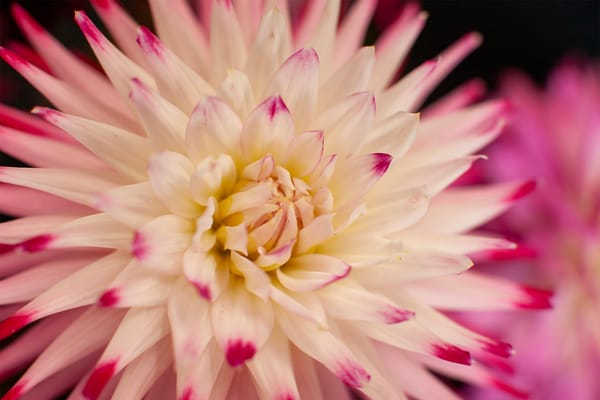Dahlias are generous plants—until they’re not. When blooms fail to appear, leaves yellow, or buds twist instead of unfurling, frustration can quickly set in. In Cornwall and coastal regions, where wind, salt, and damp conditions complicate matters, knowing how to read the signs is half the battle. This guide walks you through common dahlia problems, their causes, and practical solutions, so your dahlias thrive whatever the challenge.
Quick Diagnosis Table: Why Aren’t My Dahlias Thriving?
| Problem | Common Causes | Solutions |
|---|
| Poor Flowering | Excess nitrogen, low light, overcrowding, drought, late planting, poor soil, old tubers | Reduce nitrogen, ensure full sun, thin plants, water well, enrich soil, use fresh tubers |
| Yellowing Leaves | Over/underwatering, poor drainage, nutrient deficiency, virus, rot, salt stress | Adjust watering, improve drainage, feed balanced fertilizer, check for virus, protect from salt |
| Malformed Blooms/Buds | Thrips, capsid bugs, uneven watering, virus, poor nutrition, wind exposure | Control pests, water evenly, improve shelter, rogue infected plants |
| Weak/Floppy Stems | Low light, overfeeding, rich soil, lack of support, wind exposure | Stake early, reduce nitrogen, increase sun, provide shelter |
Poor Flowering: Why Blooms Fail and How to Fix It
Symptoms:
- Few buds despite lush foliage
- Blooms delayed or absent
Likely Causes & Solutions:
- Too much nitrogen: Switch to a balanced or potash-rich feed after June—avoid high nitrogen formulas.
- Insufficient sunlight: Dahlias need 6+ hours of direct sun; consider relocating or thinning surrounding plants.
- Overcrowding or deep planting: Ensure tubers are spaced at least 60 cm apart and planted just below soil level.
- Lack of phosphorus/potassium: Feed with a high potash fertilizer (like tomato feed) during bud formation.
- Old or undersized tubers: Always plant healthy, plump tubers with visible eyes.
Yellowing Leaves: Understanding the Causes
Symptoms:
- Uniform yellowing (lower leaves = nitrogen deficiency; upper leaves = magnesium or iron)
- Mosaic patterns or streaks may indicate virus
Key Causes & Remedies:
- Overwatering or poor drainage: Improve drainage with raised beds or organic matter; water only when topsoil feels dry.
- Nutrient deficiency: Apply balanced fertilizer; add magnesium (Epsom salts) or chelated iron for specific shortages.
- Salt stress in coastal gardens: Mulch to protect roots, site plants away from prevailing winds, rinse foliage after storms.
- Viral infection: If accompanied by distortion or stunting—remove and destroy the plant. Never compost infected material.
Symptoms:
- Twisted or incomplete flowers
- Buds aborting or failing to open
Likely Causes & Practical Solutions:
- Thrips or capsid bugs: Monitor regularly; use sticky traps, biological controls, or neem oil early in the season.
- Viral infection: Rogue any persistently malformed or stunted plants.
- Water stress: Maintain even moisture levels—avoid letting plants dry out or become waterlogged.
- Wind burn or salt spray: Provide shelter, plant in groups, or use windbreaks.
Coastal-Specific Problems: Wind and Salt Solutions
| Issue | Symptoms | Solutions |
|---|
| Wind Burn | Scorched, ragged leaves, snapped stems | Use hedges, walls, or windbreaks; stake firmly; choose compact forms |
| Salt Stress | Leaf scorch, yellowing, delayed growth | Plant in sheltered spots, mulch, rinse foliage, improve drainage |
| Fast-Draining Soils | Wilting, pale new growth | Add compost or manure, water consistently, shelter plants |
Real-Life Q&A: Common Dahlia Problems Answered
Q: My dahlias have lush leaves but no flowers—what gives?
A: Classic overfeeding or shade issue. Ease off nitrogen, ensure full sun, thin crowded beds, and deadhead regularly for new buds.
Q: Why are my leaves yellowing from the bottom up?
A: Overwatering or nitrogen deficiency. Let soil dry slightly between watering and switch to a balanced feed with trace elements.
Q: How do I protect my border dahlias from late summer winds?
A: Use natural windbreaks like hedging, choose compact dahlia types, stake with multiple ties, and mulch to stabilize moisture and reduce salt uptake.
Q: Some buds are failing to open or look twisted—why?
A: Likely thrips or capsid bug damage. Inspect for tiny pests, remove malformed buds, treat early with neem oil, and water evenly.
Your Action Plan for Healthier Dahlias
- Soil Check: Test pH (aim for 6.5–7), drainage, and fertility every couple of years.
- Feed Wisely: Use low-nitrogen, high-potash feed once buds appear.
- Water Right: Keep moisture levels even, especially in sandy or exposed coastal soils.
- Support & Shelter: Stake tall varieties early and use windbreaks where needed.
- Inspect Weekly: Look for early pest or disease signs and act before problems escalate.
- Rogue Relentlessly: Remove plants with consistent virus symptoms—don’t risk your entire bed.
In Conclusion
Vibrant, floriferous dahlias reward attention to detail. By tuning into your plants’ signals—yellow leaves, shy blooms, or wind-battered stems—you can quickly correct course and ensure a thriving display. Whether you’re battling Cornish winds or coaxing blooms in a sheltered border, practical troubleshooting is your best tool for healthy, spectacular dahlias.











